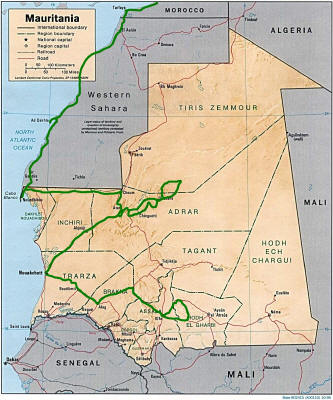 Second Instalment
Second Instalment
Mauritania was much more than we expected. My thoughts were that we would have a quick squiz at the Adrar region, then head to Mali via Agadir. A fast pass through. As it was the desert got under our skin and we spent 6 weeks in Mauritania and left Mali for another time.
Sunday 15 to Monday 16 January 2012, Noudhibou
The border was lengthy but not difficult. The Moroccan border post is about 5 kilometers from the Mauritanian border post. The road in between is not maintained by either side, is very bumpy and littered with car wrecks. One car had a cover over it but since it must have been there for a while the cover had been torn to shreds by the wind. No Land Rovers though and therefore no possibility of a Land Rover step.
We ended up with a "helper" who did a lot of the running around for us. As usual not really worth it. He also organised insurance which we may or may not have to show at a police check point. Apparently this is quite a random event.
Mauritania is a poor country. You can see this in the well washed clothes, the small shops with little in them and the general quality of everything. At least Noudhibou had an ATM and we could raid the bank. At this point we are not sure when we can get more money and our supply of Euro is limited.
Tuesday 17 to Thursday 19 January 2012, along the railway to Atar
The track along the railway to Atar is supposed to be quite reasonable - for a track. It wasn't too bad at all. We started out following the tar road to the capital but missed the turnoff. Instead we headed for a track on the GPS. We didn't actually see it and so headed north through the desert. We came across it some time later. Yes, because we just headed north we got caught in the sand. The sand ladders have now been initiated for use in sand rather than snow.
The first night was spent near a tree somewhere south of the railway line. The next day we came across the railway line and a graded dirt road. We really started to wonder what all the fuss was about. A Mercedes could follow this road. Then we hit a long stretch of sand. The wind was very strong and had obliterated the road. Now we needed the 4x4 capabilities of our car. From time to time the graded road reappeared. Still the railway line is a good reference point. We learnt later that 2 days before you could follow the graded road the whole way, before the wind started. There were herds of camels at various points along the line. I assume they were going to be transported on the train, but it may have just been because of the availability of water. This night was spent near the railway line. About 9:00PM the first train went by. It took 5 minutes to actually pass us plus more minutes before and after hearing it. It is one of the longest train in the world and has up to 5 engines and is up to 2.3 kilometers long. Apparently there is a slight downhill on the way to the port at Noudhibou which allows it to carry so much ore. It is empty going inland. There were 5 more trains during the night and we heard each one!
On Thursday we came across our first checkpoint. A man stepped out waving a gun at us. It was a bit disconcerting so we stopped. It as the usual procedure, where are you going, where did you come from, copies of your passports please. The road continued to be a mixture of hard surfaces and ridges of sand. The wind was so strong that we sometimes we could not see in front of us. The sky seemed to be full of it.
I
had a waypoint for Aisha and we headed north of the railway to see it. Aisha is
a very large rock, possibly third largest in the world. In December 1999 a
symposium of sculptors was held here and they used the rocks at the base to make
sculptures. They are very interesting and we spent some time wandering around
looking at them. Next stop was Ben Amira. This is the second largest rock in the
world rising 633 meters above the desert. Uluru in Australia is the largest. I
didn't have a way point for BenAmira, just that it was east of Aisha and visible
from the railway line. It made a lovely camping spot for the night. We tucked
ourselves away on the north side out of the wind and the sound of the trains.
The silence of the desert is wonderful. Before dinner I walked around Ben Amira
in about 2 hours. It was a nice walk, not very strenuous at all until I decided
to take a short cut between it and another much smaller large rock. That was an
adventure. It was quite steep going up on soft sand. I tried to keep to the
rocks but that was not always possible. Sometimes it was a case of 2 steps
forward, one back. I doubt it took any less time than if I had gone around the
smaller rocks. The wind was very strong on the south side. I ended up with a
head, face, neck, shoulders and back full of sand. A wash after was wonderful.
There is a reason why desert dwellers cover themselves up totally.
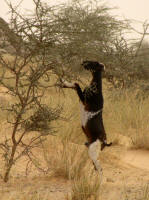
Friday 20 to Monday 23 January 2012, Atar
Atar is a gem of comfort after the desert. Hot showers, fruit, vegetables and fresh bread. It is also a place to relax and do all the household chores. No they are not really contradictory statements. After so long in Western Sahara and then Mauritania we had lots of sand and dust everywhere, plus washing. Bab Sahara have a washing machine - what luxury. There were other overlanders as well, amoung them Rencina and Allan from Australia and Mark from Britain. Martin and Eva, whom we had met outside the Mauritanian embassy arrived on Sunday. They had come along the railway line in two days because the road had been so good. Then they had headed to Tidjikja and took a wrong turn and became bogged down in dunes that went on forever. They had to return to Atar.
Sunday was a day out. Mark took Rencina, Allan and Susanna (a German lady who winters in Atar) and we followed. First stop was Terjit. This is an oasis where there are hot and cold springs which merge between red cliffs. There is supposed to be a warm pool for swimming but it was far too shallow. Maybe its deeper at another time of year. It was so very pleasant to walk between the date palm in the cool air. We spent some time just enjoying the ambiance before returning to our cars and the impromptu market that had been set up in anticipation of tourist dollars. Unfortunately there weren't many sales. The village has some traditional houses made of grass and some of stone with grass roofs. They are small but perfect for the climate.
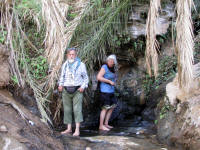
Next came a drive through Oued Abiol or Vallee Blanche. Mark can speak reasonable french and when we missed the way he was able to ask directions with ease. The valley is beautiful with white sand, yellow sand, brown mountains and green trees. It looks pristine. Once again there was soft sand and Pieter got stuck. Mark and Allan are experienced and gave him several pointers on avoiding such situations. These came in handy for our next foray into the desert.
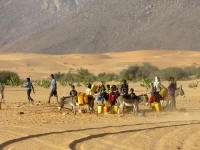
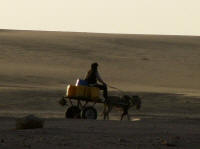
Tuesday 24 to Sunday 29 January 2012, the Adrar via Chinguetti, Tanouchert, Ouadane, Guelb er Richat and El Ghallaouiya
The Adrar is touted as the jewel in Mauritania's crown and it is magnificent. We truly enjoyed our 7 day trip even with all the difficulties of losing the tracks again and again. The peace and timelessness are awe-inspiring. The sky was very clear on several nights. I felt I could touch the stars. I could see the Milky Way very clearly, something no longer possible in Europe. There is nothing more calming than being totally alone in the vastness and imbibing the ambience. It makes you patient. After all if you are stuck in the sand you have to spend the time required to get out. There is no point getting frustrated and trying to hurry anything. Of course it helps to know you are totally self sufficient and have the time. It also helps to have a GPS and way points! That way you are never truly lost because you know where you have to go even if you don't know what the terrain will bring.
We
started by following the graded road to Chinguetti. Once we were up on the
plateau we turned off the road and headed south towards the Zarga region. Then
east to Chinguetti. Here we had our first mishap. We lost the track somewhere
going up the valley to Chinguetti and ended up in sand dunes. We looked at the
terrain and decided to head to an area with grass as it should be more stable.
This meant going across even more dunes where we ended up getting stuck. We
ended up going deeper and deeper into the sand as we tried various options. In
the end the rear axle and diff were lost deep in the sand. In then end it took
over 3 hours to dig ourselves out leaving a knee deep hole. Then we had to dig
out one of the sand ladders which had gone almost straight down into the sand.
My back, shoulders and arms were so sore I took an anti inflammatory with
dinner. I didn't have pain the next day, thank heavens. Once we had freed
ourselves we chose a relatively hard patch and camped for the night. I am quite
sure the knowledge Pieter picked up recently prevented us from getting stuck
more often. One learning point rather overdo the preparation to get out than
spend hours achieving the same goal. A high lift jack would have been welcome.
Once we were on harder ground we found the track to Chinguetti and the driving was bumpy. The recent rains have brought the grass to life. The wind blows and sand collects in the grass. You can't avoid all the small humps only the larger ones.
Chinguetti was a caravan town, making its wealth from the large salt caravans, capital of the Moors and a centre for Islamic scholars. It is the 7th holiest city of Islam. The mosque dates from the 16th century. Lack of tourism has had an impact on the town. We wanted a good cup of coffee and went to the most expensive auberge in town. The coffee was great even if instant. The hot water, milk and sugar were served seperately. The auberge has seen better days though. It has the occasional politician to stay and very occasionally another guest. There seemed to be only one man employed there.
We were looking forward to spending the night in a campground at Tanouchert. This is a dying oasis where the sand is creeping over the date palms. We found the auberge and asked for a meal. First though was tea. As in Morocco the tea has mint and sugar added. The water is boiled in a small teapot that already has sugar added. The tea and mint are added once the water has boiled. Then the pouring starts. This is an almost endless process involving pouring some tea from one small glass to another from a height. Foam is created by the process. Occasionally extra tea is added from the pot. Finally you are given a small small glass of very sweet tea. You are expected to have a second and maybe a third. Both after more pouring. Two is my maximum, it is enough sugar for a day. We spent a few hours waiting for a meal and watching family life until we were so hungry that we went to the car and made a quick meal before going to bed. About an hour later the meal was ready but far too late for us.
When we arrived one of the women was making couscous. I don't know how the process is started but she was separating the larger balls from the smaller and then adding flour to the smaller ones. Later the call to prayer came. One man took a handful of sand and used it to wash his hands. He then did one repetition of the prayer. After dark the young boys started reading a French primer. They had couscous and sugar for supper. The adults eat in the afternoon. The night was not as peaceful as in the desert. The baby seemed to cough all night and the donkeys brayed.
In the morning we made breakfast and paid. The finances were handled by the wife. She took me aside to discuss the price but of course Pieter had to get involved because my French is almost non-existent. The bangles etc came out but I only purchased some pancakes. These were quite nice but had some sand mixed in. Made me wonder how much sand they have in their diet.
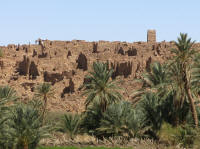
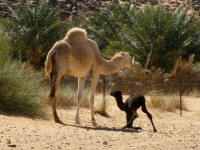 Our
target today was Oudane. The old town is made from the local stone and is almost
invisible until you are up close. Founded by the Berbers in 1147 it was a
prosperous caravan centre and a transit point for dates, salt and gold. It was
also place of learning. Now it is quite small but has an active town centre. On
the outskirts we came across a truck selling gas. We had just finished one of
our bottles and were able to fill it up direct from the truck. What a find! Of
course the truck moved on once the nearby residents had filled their bottles.
The night was spent in a grove of trees outside the town. There was so much wood
we were able to have a campfire. What bliss!
Our
target today was Oudane. The old town is made from the local stone and is almost
invisible until you are up close. Founded by the Berbers in 1147 it was a
prosperous caravan centre and a transit point for dates, salt and gold. It was
also place of learning. Now it is quite small but has an active town centre. On
the outskirts we came across a truck selling gas. We had just finished one of
our bottles and were able to fill it up direct from the truck. What a find! Of
course the truck moved on once the nearby residents had filled their bottles.
The night was spent in a grove of trees outside the town. There was so much wood
we were able to have a campfire. What bliss!
We were going to have scrambled eggs for breakfast. Pieter had purchased 4 eggs in Atar and the first two made lovely boiled eggs. This time when he went to crack the eggs he couldn't. These ones were already boiled. We could only laugh.
The Guelb er Richat is a volcano that did not erupt. Successive layers of magna bubbled up forming large rings. Erosion has left these ridges bare. The track leads up and over each successive ring and through the valleys in between. The ridges clearly go around in a circle. The rocks consist of various minerals melded haphazardly together.
The entry point is not clear even though we had a waypoint. After driving backwards and forwards we asked directions from two young children who came running to help us. The young boy wanted to come along as our guide. We are always glad when we can point out that there is only space for us. He explained that the track started where the black ended and the white sand started. This time the entry point was a clear pass between the hills. The rocks created by erosion litter the ground making driving difficult. The track is reasonably clear though. On the other side of all the rings the wind had done its work and covered the track with sand. We ended up making our way over horrible large rocks. At least we could see the break to head for in the next ridge and that is where we found the track again. This time it went through a large field of river stones where once again the sand covered the tracks. We drove through an extremely bumpy river bed of grass heading for a distant mountain where yellow tracks were clearly visible through the black rocks. The track up this mountain had been cleared a little but was very steep. I would hate to have to make my own track. The top of the mountain is actually a desolate very rocky plateau. El Beyyed, our destination for the night was up and down several more rocky passes. We decided to camp in a wadi some distance from the village expecting to have no visitors. We had been seen though and after about an hour we had a group of young girls come by and set up an impromptu market of the usual bracelets and necklaces. These were made of multi-coloured rocks from er Richat. They stayed and stayed making a nuisance of themselves.They were eager to have a photo taken which was nice. Eventually we decided to move away. We felt they would be back the next morning.
Once again we had to go up onto the rocky plateau through a narrow pass and later down again. When the road split into two we took the wrong turn and ended up heading north over soft sand. Pieter did not like it as there was no place to stop, you just had to keep going. He did not want to turn back though. We continued for quite some time until he admitted defeat and we headed south east. Making your own track is not always a good option. It looked good to start with then we ran into dunes with patches of very soft sand. Pieter is much better at avoiding getting stuck other wise we would have spent hours digging ourselves out. At one stage we ended up in a bowl of sand with many hillocks of grass. It took quite some maneuvering before Pieter managed to get out. I walked the route for a while picking out the best options until we could see the end. The dunes had one last hurdle for us. Going up a steep dune Pieter got stuck half a meter from the top. He may not have made it on the next try so out came the sand ladders and he was over in seconds and hard ground was right there.
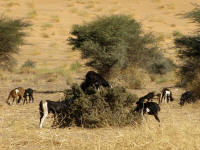
The destination was El Ghallaouiya, a place in a canyon where there were Neolithic rock carvings. The area had been much wetter then. Some of the carving look recent and they have not been precisely dated. The canyon was a lovely place to camp.
Today we expected to reach Oudane and with some luck Atar. Luck was not with us and we didn't even reach Oudane. The track started over an endless grassy windswept plain with only the remnants of tracks. The sand was fully embedded in the plants and it was impossible to avoid continually going over small hillocks. We had been told the track to Tanouchert would be bad but this was infinitely worse and it went on and on. Going fast was not an option. There were sections of very rocky ground. In one of these we were actually following a track over a small rocky ridge. It was impossible to see the best route down over some very large rocks .I got out to guide Pieter down. He was heading for the wrong place about a meter from the right place and had to reverse. I saw puffs of sand near the back wheel but assumed the cause was patches of sand. He made it down but soon there after realised he had a flat tyre. He managed to stop on what appeared to be hard ground. The wall of the tyre had been pierced by a sharp rock. The jack is manual but difficult to turn because the hook is worn down. In any case it was too long to fit under the axle which was almost on the ground. No problem, fairly hard ground, dig down. The hard layer was very thin and underneath - soft sand! It took over an hour to change the tyre. Eventually a rock was placed under the jack and several under the springs either side of the axle on the hard layer to prevent the car from sinking. Then a hole was dug to enable the tyre to be removed and a spare put on. We are getting tired of digging in sand! Oh for a high lift jack!
Wild camping is a pleasure and a wonderful respite after a hard day. Finally our last day in the desert came. Across the dunes again to find a track. Surprisingly in the middle of nowhere an Arab appeared. He had stone age looking cutting stones for sale. He confirmed our thoughts on the possible route to take. Oudane was reached by lunch time. We looked for bread and a man said he had. Actually he didn't. His wife went and bought it. He gave us some tea though and part of a loaf that he kept. The tea and the bread were ambrosia. You would think we had been in the desert for years the way we enjoyed it. Our rations had been rather plain, all from tins. The road back to Atar is graded and went relatively very quickly. Back to the luxury of a campsite, hot shower, fresh food and plenty of water. Our 60 litres had almost gone even though we had used it sparingly for washing dishes and occasionally ourselves.
During the journey we went up and down some very steep dunes. The photo is not the steepest descent. At the top it is an act of faith to head into the sky. When you go down you lose all perspective of where you are heading. The only way to tell is by the angle you have to sit in the seat. Just like a roller coaster ride.
Monday 30 January to Saturday 4 February 2012, Atar
Rest time at Bab Sahara our home in the Adar region. We had several meals in restaurants including spicy minced camel meat, rice with a vegetable sauce and the standard chicken and chips. The washing was done and the car fairly well cleaned. Relaxation was the order of the day though. We decided to wait for the festival in Oadane, going for the third and maybe fourth day. This would allow the officials to leave.
Sunday 5 to Monday 6 February 2012, Oudane
The trip up the graded road was not as uneventful as we would have liked. The tyre that had the side ripped on our trip had been patched. It was supposed to be OK to drive on. It wasn't. The wall blew out again. I was glad this happened on such a well used road rather than in the desert. The road was being very well used. It has probably never seen so many cars at a time. The officials were returning to Atar to catch the plane. Locals were going to Oudane. Many cars were busy changing tyres! That included us - again. The side wall again but on the inside, and this on a road that was being actively graded. Two of our expensive mud terrain tyres with reinforced side walls were now kaput. And no spare! Jean-Renault and Madeleine came along when we were almost ready. They followed us - in case. We continued on as we were close to Oudane. After a look around town to see that nothing was really happening we both camped behind a group of palm tree which thankfully blocked most of the wind.
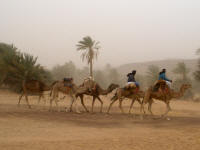
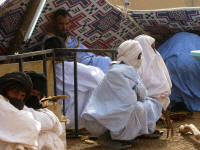 The wind blew fiercely all night but not
against us. It was still blowing fiercely and coldly next morning. The festival was a blow
out. No music, no camel races, just locals with their souvenirs for sale. They
huddled in tents or braved the wind. There were quite a few tourists around so
they did some business. It was really not worth staying especially as we are not
souvenir buyers. In any case the last of our local money had been used to pay Bab Sahara. The International ATM at the local bank did not like Pieter's Visa
card and it swallowed mine. We found out later when we retrieved my card that a
chip was required. Unfortunately our Visa debit card does not have a chip.
The wind blew fiercely all night but not
against us. It was still blowing fiercely and coldly next morning. The festival was a blow
out. No music, no camel races, just locals with their souvenirs for sale. They
huddled in tents or braved the wind. There were quite a few tourists around so
they did some business. It was really not worth staying especially as we are not
souvenir buyers. In any case the last of our local money had been used to pay Bab Sahara. The International ATM at the local bank did not like Pieter's Visa
card and it swallowed mine. We found out later when we retrieved my card that a
chip was required. Unfortunately our Visa debit card does not have a chip.
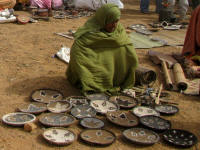
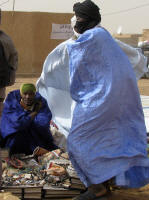
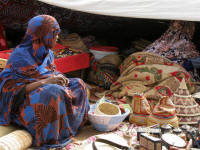
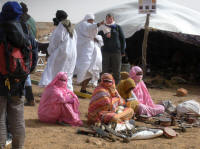
About 20 kilometers outside Oudane the worst happened. The wall of a third tyre was cut by a random rock. We parked off the road and waited for the right car to come, that is one with a spare wheel with 5 nuts. Many cars stopped but they all had the wrong wheels. Jean-Renault also came along a little later but he had 6 nuts.
Hamedea came along with a double cab loaded with goods and people. He said that wheels with 5 studs were not readily available and he should take one of us to Atar with 2 wheels to buy second hand tyres. He would then come back that night. It was considered too dangerous for a woman to stay alone so I was the one assigned to climb into the back of the bakkie and go to Atar. There are quite a few cars with wheels with 5 studs but his advice was sound anyway. Me? I do not know that much about tyres, I can't speak French, I am not good at bargaining. I think Pieter would have been the better one to go. But I was sent off with a lot of strange men into the wild blue yonder. I took all our Euros and enough copies of my passport for the police checks. The ride wasn't too bad. There was a blanket, I had warm clothes (the wind was cold) and a scarf to cover my head and face. All very necessary. To start I was sitting on part of the spare tyre, very bum numbing. At Chinguetti one back passenger alighted and I took that place sitting on someone's luggage. Much softer. When we arrived in Atar it was a matter of buying 2 identical tyres. Small ones as it turned out because that was what was available. They then had to be put onto the rims. Bab Sahara was a stopping point to let everyone know what was happening and to change money. Two hours later we were on our way again. This time I noticed the cars stopped by the side of the road - fixing tyres! There were at least 6. Hamedea stopped to help one car as they did not have the right spanner. Another car was obviously in the same predicament as us. The wheel was missing and the passengers were huddled around a small fire trying to keep warm. At least Pieter could cook a meal, lie in bed and keep nicely warm. We arrived back at 10:00pm. I paid Hamedea with the last of our money - again! A cup of tea for me, some chocolate to eat and we both went to bed.
Tuesday 7 to Wednesday 8 February 2012, Atar
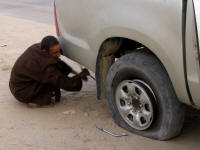 Hamedea came by in the morning with a
load of goods and passengers. He stopped to check up on us and assured we were
OK went on. At least this trip was uneventful - for us. This time there were 6
cars with flat tyres and one with engine problems. One of the flat tyres
belonged to Hamadea! He had had one yesterday in Atar as well. Now that same
tyre was back on the car. It is almost bald all over with some canvas showing
but with an inner tube.
Hamedea came by in the morning with a
load of goods and passengers. He stopped to check up on us and assured we were
OK went on. At least this trip was uneventful - for us. This time there were 6
cars with flat tyres and one with engine problems. One of the flat tyres
belonged to Hamadea! He had had one yesterday in Atar as well. Now that same
tyre was back on the car. It is almost bald all over with some canvas showing
but with an inner tube.
In Atar we first went to the back for my card and the bad news about Pieter's. At Bab Sahara we discussed our financial situation and Just offered to lend us the money to buy another 2 tyres of the correct size and enough diesel to get to Naukchott. He took Pieter around town and found the right tyres. Pity I hadn't found them yesterday. He obviously has better contacts for these tyres than Hamadea. One of the bolts had been stripped and was also replaced. When we tried to return the small tyres we discovered that the actual cost of the tyres was less than half of what I paid. I hate that, it makes me feel stupid, inadequate, small and very angry with myself and the people who ripped me off. At least only a small minority of people are like that. Apparently Moroccans do the same to each other so none of them trust any other Moroccan.
Thursday 9 February 2012, on the road
Yes it happened again! We had one spare tyre. The last original All-Mud Terrain tyre got a small leak. We continued with no spare. Then one of the second hand tyres totally dissolved. We were all of 30k from Atar. This time we flagged a passerby and phoned Just. He sent a driver who picked up the leaking tyre, the totally blown tyre and the spare rim. Hours later he returned with two borrowed tyres and a fixed tyres. We camped nearby for the night.
Friday 10
to Thursday 16 February 2012, Nouakchott
We made it without further incident. It is Pieter's 76th birthday so as soon as we had taken money from the bank, at last, we had coffee and croissant. Later we had a lovely meal at a Senegalese restaurant near the campground followed by a Magnum ice-cream. Delicious!
First we had to buy tyres and send the borrowed ones back. This was done on Saturday with the help of a friend of Just's. Next we had to decide whether to dash to Mali or extend our stay in Mauritania. There was a lot of admin to get up to date and the Auberge had excellent wifi. Pieter also had business with the Dutch Consulte. Mauritania won. Extending our visa was another big problem though. The address in the LP was no longer valid. This meant asking people where to go. Usually this is not a problem. Not this time. We were sent to the Department of the Interior, sounds reasonable. They did not extend visa. The building was just around the corner. We went for a walk. It was definitely NOT around the corner. We returned to ask for more specific instructions. This time an official said we could follow his car and he would take us. Great! He took us way off to somewhere near the Olympic Stadium, also the Department of the Interior. OK, possible. They did not extend visa either. Not only that but they advised us to go to the Dutch Consulate. To extend our Mauritanian visa? They must be crazy! We started all over again and ended back at the original Department of the Interior. The building is just over there they insisted. Eventually they asked someone to guide us there. Off we walked. By this time neither of us was feeling very patient. When we had walked about five minutes well away from anywhere near the Department of Interior, Pieter put his foot down and refused to go further. Our guide immediately asked a passing car to give us a lift. OK but by this time we were lost anyway. Another 5 minutes later we arrived at the office. Just over there, you can't miss it? I don't think so!!!! We were told to come back tomorrow at 8:00 am as there would be looooong queues. Very early for us but worth the effort. We asked where the main street was as well. At least if we got there we would be able to return.. By this time we had spent over 4 hours trying to find the right building. It took another 15 odd minutes to walk back to our car which was parked further along the main road. Next was finding the Dutch Consulate. We had an address which we couldn't find. Back at the Auberge Pieter used Skype to phone the number given, without success. He then did some more research and found out that there was actually no representation of Holland in Nouakchott.
Next morning we were up early and off to the Securitie to extend our visa. We were early but there was a man there. He told us we needed a paper from the Auberge! Back to the Auberge but only the manager could provide this. Once we had that, several hours later, we returned to the Securitie and after an hour we had completed the paperwork and could pick it up the next morning. As for the queues, well I don't call 3 people a looooong queue.
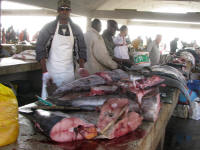
The fish market is very colourful and lively. The boats were already on the shore when we arrived and many of the fish had been taken out of the market on donkey carts. We bought two flat fish and had them skinned and beheaded. Pieter enjoyed all the joking about choosing the fish and the price. As usual I just stood back and watched.
Friday 17 to Tuesday 21 February 2012, Ouaker (Waker) Depression
What is the colour of Mauritania? Blue or white. Not only for the overcoats of the men and their turbans but also for the buildings, although green, purple and orange are also used. This was never more obvious once we left Nouakchott and headed west. There were many roofs painted these colours. Often there was only the roof with poles to hold it up. The first walls are of material. Only later are brick walls added. They hint at the recent use of tents. The countryside is different too. There are so many trees and shrubs it looks positively lush when compared to the north. There is no undergrowth though only miniscule plants that the goats find. This is definitely the Sahel. The sand seems to be winning though. It moves over trees and houses. Some houses are now sitting in their own little depression. The trees are doing their best to hold the sand back but it seems as if it is a losing battle. The people are less friendly as well. Sometimes they are downright surly. Of course they want to get as much money out of you as possible. We stopped in Aleg to buy bread and the first seller wanted to charge 10 times the amount in Nouakchott. I was sure I had mis-heard, but he repeated the price. He lost a sale. The road is tarred to Kiffa. There are many trucks carrying cows, of which there are many. The cows - and donkeys and goats and sheep - have no road sense. They are killed and left to rot by the side of the road. I guess road kill is not halaal so they can't be eaten. There are also many car wrecks. We decided that in this part of the country you can tell you are coming to a village by the number of car wrecks, dead animals and rubbish. Since there are more people living in this area than in the Sahara there is a lot more rubbish.
Past Kiffa we were told by the Gendarme that there was a better road to Tamchaket than the one we were heading for. The one we had intended to do was 'tres difficule'. By this stage we were fed up with the pot-holed tarred road. Past Kiffa the road has been so badly damaged that it is being torn up and hopefully replaced. There are deviations everywhere and some of the road has not yet been torn up. So we took the direct route. We found some lovely camp sites away from the road amoung the trees. This one was near rocks shaped by the wind. I saw a giant iguana, a snake head and a sheep head amoung other formation. The road is graded and smooth. Infrastructure is being put in place along it - such as electricity and cell phone towers. Presumably water pipes will follow. At Tamchaket we asked if it was possible to drive through to Tadjikja. We have a map with a road on it but that doesn't mean the road actually exists. We were told it was impossible but we could go through to Boumdeid and then back to Kiffa. We were now into the multi-tracked desert. As it was we missed the turnoff to Boamdeid and went straight to Kiffa. The route goes through a lake area. I use the term loosely. The GPS map shows lakes. On the ground there are many more trees in that area. So many trees that there was actually extensive areas of solid shade! One area was magnificent. You could imagine that there was water in a lovely pool. I was so busy admiring it that I forgot to take a photo. There are (relatively) a lot of people living in this area. Some have fenced off the land which begs the question - How did they acquire it? Did the government sell it to them or did they just take it over? The people were originally nomadic and I presume the land belonged to the tribe. Unfortunately I don't have the language skills to ask such a question. The result is that the tracks run through the fences. Detours have been made. The fences must be fairly new.
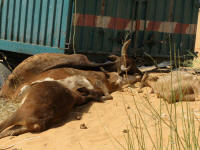
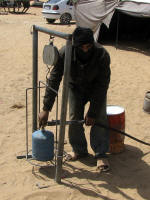
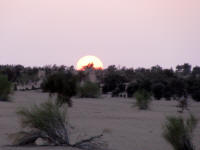
Wednesday 22 to Saturday 25 February 2012, to the border
After some days in Nouakchott again purchasing food and washing clothes we headed north to Morocco. The time was wholly uneventful.
| Averages | Euro | ||||
| Cost per litre diesel | 0.93 | ||||
| Camping per night |
10.71 |
||||
| Hotels per night | Africa Menu | ||||
| Kilometers traveled |
10,812 |
||||
| Days in the country | 42 | Home Page | |||